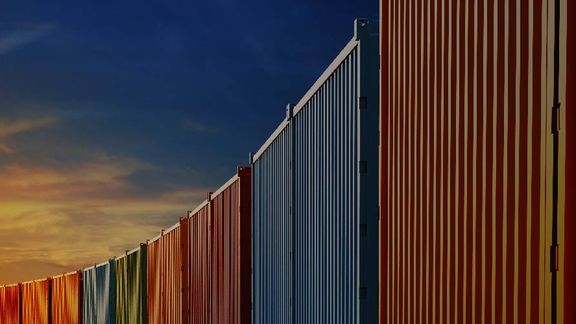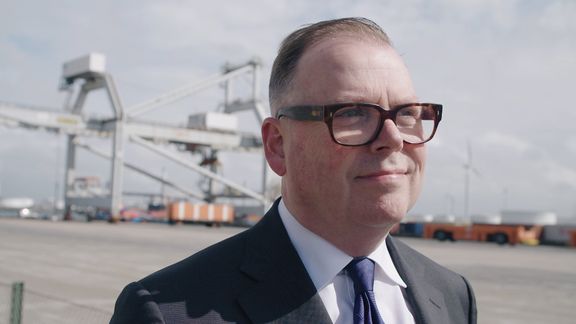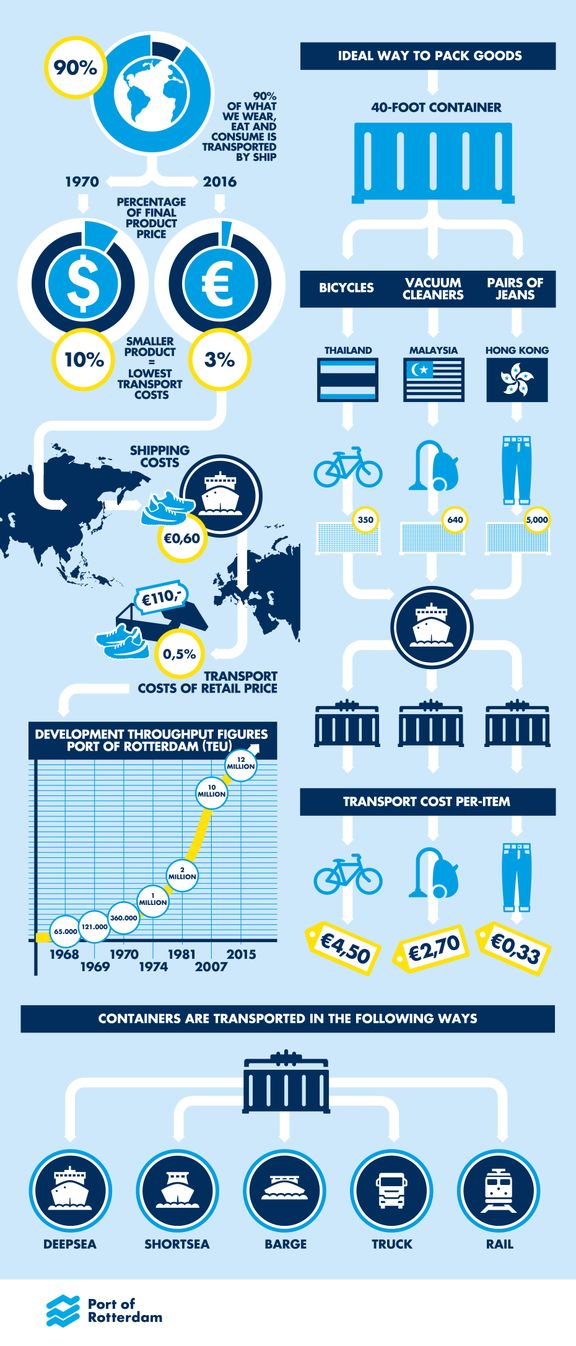How a steel box changed the world economy
Port Authority published this article in 2016, when the container celebrated its 50th anniversary.
The container has existed for 50 years. How a simple box changed the world economy and made the Port of Rotterdam a container pioneer.

If you have ever packed your car for a holiday, you know what it’s like. Things in different sizes, that take a lot of ingenuity to fit them all in. And just when you think you’ve figured out the right lay-out, you discover that the tent is still lying on the ground beside the car and you have to start all over again.
That is exactly what loading and unloading cargo looked like until 1966. Cargo came in different shapes and sizes and sometimes dockworkers had to toil for weeks to load and unload a vessel in a decent way. Until the American Malcolm McLean came up with the idea that it would be much more efficient if everyone worldwide were to use an identical container. He invented the container that we still use today. A steel 40-ft or 20-ft box, with swing doors. Very simple.
He devised the container that we still use 50 years later. A steel box of 40 ft or 20 ft, with hinged doors. The strength of the container is its standardisation: every container has the same properties worldwide, so it can be lifted anywhere by its corners,' says Bart Kuipers, policy advisor for ports at the Erasmus University. He calls the container 'the invention of the century'. 'All the infrastructure in logistics was geared to these standard containers: sea-going vessels, cranes, trains, trucks and inland navigation vessels.'

Whisky was drunk
Soon it was impossible to imagine logistics without the container. “These steel cargo boxes led to a huge productivity increase in transport. Things could be done much quicker and cheaper now. Ships used to be in port for weeks, but now the same work was done in just a few days,” says Kuipers. “The impact on the world economy was immense.” According to The Economist, the container has been more of a driver of global trade than all trade agreements in the past fifty years taken together. And not just that, the container brings other advantages as well. Kuipers: “For instance, in the old days it wasn’t possible to transport whisky by ship, because the dockers would drink part of it. But stowed in a container it was no longer in reach. Obviously there are disadvantages as well; drugs for instance, are often hidden in containers.”
The port of Rotterdam was one of the first ports to take containers seriously from the start. With the Rotterdam Municipal Port Management as co-initiator, a number of stevedoring companies established the Europe Container Terminals (ECT). “ECT fully focused on container transhipment and for that purpose it developed and exploited the first specialised container terminal, in the Eemhaven,” says Rob Bagchus, Chief Public Affairs & Public Relations Officer of ECT. “This innovation and many that have followed since, have given Rotterdam a lead over other ports. Thanks to ECT the port of Rotterdam has become a big player in the container business.”
Since then, container transhipment in Rotterdam has developed at top speed. Container cargo is usually measured in TEU, which means Twenty-foot Equivalent Unit, i.e. a twenty-foot container. A regular large container, like the ones you see on trucks, is two TEU. The short, smaller container is one TEU. Over the years, the number of transhipped containers rose fast, from just 65,000 TEU in 1968, to 1 million in 1974 and 12 million in 2015. And the port continues to grow; the construction of a new generation of revolutionary container terminals at Maasvlakte 2 being one example. “As a port, we never cease to do our utmost to offer companies the right circumstances to settle here, so that they will continue to invest in the port of Rotterdam, and sufficient business activity is being attracted,” says Emile Hoogsteden, director Containers, Breakbulk and Logistics of the Port of Rotterdam Authority.

Fifth-largest exporter in the world
“The container has made it possible to manufacture every part of a product wherever it is cheapest”, Hoogsteden continues. “Today, 90 per cent of what we wear, eat and consume is being transported by ship.” The Netherlands is the fifth-largest exporter globally in terms of goods trade, before countries such as France, South Korea or the United Kingdom. Much of that trade is shipped in containers.
On top of that, container ships have become bigger and bigger, which has resulted in transport costs per product becoming increasingly lower. In 1970, transport by sea accounted for about 10% of the final retail price. Today, this is just 3% on average. Transport costs are the lowest for small products: take a pair of shoes manufactured in Asia for instance. Shipping a pair of shoes to Europe costs about 60 euro cents. At a retail price of 110 euro, the share of transport costs is only 0.5 per cent.
Bart Kuipers also points out the impact of the container on Asia. “Because we can now import many products from Asia at a low price, some five to six hundred million people in Asia have become part of the international production system, which has enabled them to prosper.” But global trade has, for instance, also improved access to better health care. Emile Hoogsteden: “An increasing number of people have access to the latest medicines and developments in medical science.” Education profits from global trade as well: for example, 25 years ago only half of the children in Africa visited a primary school. Meanwhile this figure has risen to three-quarters of all children.
Transporting empty containers
Of course there are also disadvantages. Transport by sea containers can be a lot slower than the consumer would like. Kuipers: “Sometimes a container with garments takes so long that the colour has gone out of fashion by the time it arrives.” Furthermore, the ships emit large quantities of CO2 and many empty containers get shipped back and forth. Kuipers: “Because shipping these empty containers is cheaper than shipping full containers, they are stuffed with minor cargo.”
During all this time the container itself has hardly changed, although it has become a bit more advanced. For example, there are reefer containers, for goods that require temperature-controlled conditions. And there are containers that are foldable. Holland Container Innovations (HCI) for instance, has developed the first 40-foot foldable container that fully meets all industry requirements. Kuipers: “We see a shift of products traditionally being shipped by air – such as flowers – now being shipped in sea containers. And goods that are normally transported in special vessels, such as bananas, are also increasingly shipped in containers.” In addition, more and more special software for containers becomes available, such as container code recognition software.
But what has mainly changed in the past fifty years, is the infrastructure around the container. “No one had expected container ships to become this big,” says Kuipers. “Twenty years ago a professor said: there will be vessels that can carry 20,000 containers. He was put down as a fool, but meanwhile they are a reality.”
This is happening because the online retail market continues to grow. Forrester Research is forecasting online retail in Europe and the USA to grow at 10 per cent a year. Growth in Asia will be even stronger. For example, by 2020 the Chinese online retail market is expected to be as big as the markets of France, Japan, Germany, England and America combined.
Visionary entrepreneurs
This makes it necessary to anticipate for that future. Emile Hoogsteden: “We are constantly innovating and looking to the future. You don’t build a port for just a couple of years; you have to plan ahead for decades.” Kuipers: “So far, the port has been forward-thinking. In the early 90s the Port of Rotterdam Authority published the Port Plan 2010 which in fact covers everything that was built in the recent past – such as Maasvlakte 2 – or is still going to be built, such as the Blankenburgtunnel. So almost 30 years ago, they already thought this through. And now, containers are the mainstay of our country. So the people who recognized the potential of the container at an early stage were genuine visionary entrepreneurs and policymakers. True container pioneers.”
In that respect, ECT has played an important role. In the 90s for example, it introduced the first ‘automatic terminal concept’. “For many years we were the only terminal operator in the world that combined manual labour with automation in such an innovative way, through Automated Guided Vehicles (AGVs) and Automated Stacking Cranes (ASCs),” says Rob Bagchus of ECT. Meanwhile RWG and APMT have also built fully-automated terminals, at Maasvlakte 2.
The Dutch port infrastructure has been elected best port infrastructure in the world by the World Economic Forum several times. Emile Hoogsteden: “A good infrastructure is essential for a port’s growth and development. Billions have been and will be invested in the expansion of the intermodal network, the construction of Maasvlakte 2, quays, state-of-the-art terminals and ICT systems, to name a few. But next to the physical infrastructure, the digital infrastructure is of major importance. By creating transparency across the chain and by sharing data, we can further increase the efficiency and reliability of the logistics chain. Rotterdam is fully committed to that.”
The container itself will probably continue to exist, Kuipers thinks. “Although it will of course evolve, in step with everything else. At the end of the day we’ll probably have intelligent containers that know their destination.” So he doesn’t see them disappear any time soon. “It’s just like the invention of the wheel. You cannot imagine the world without it.”